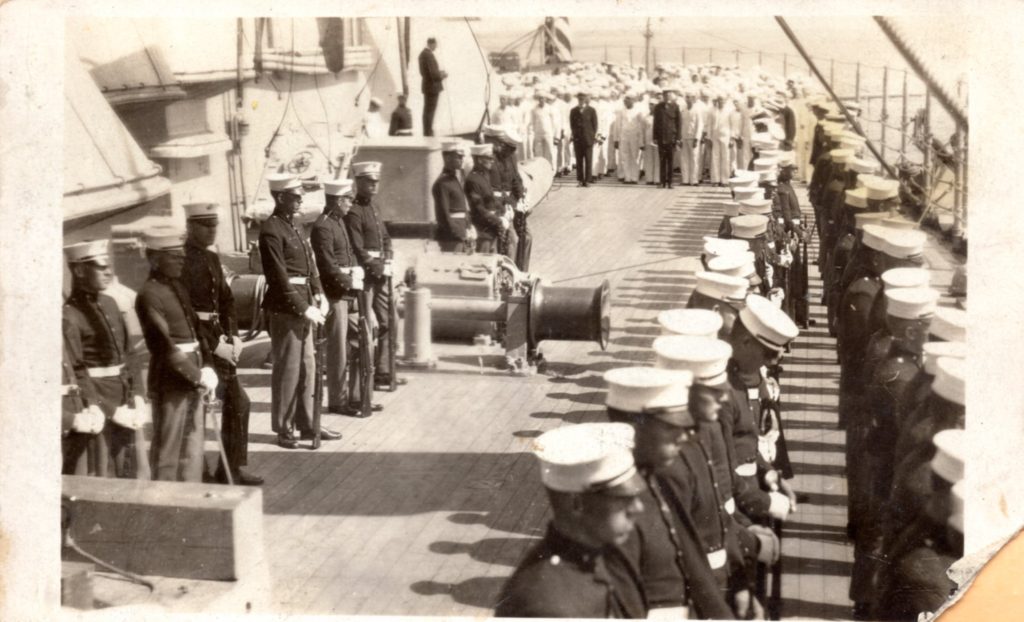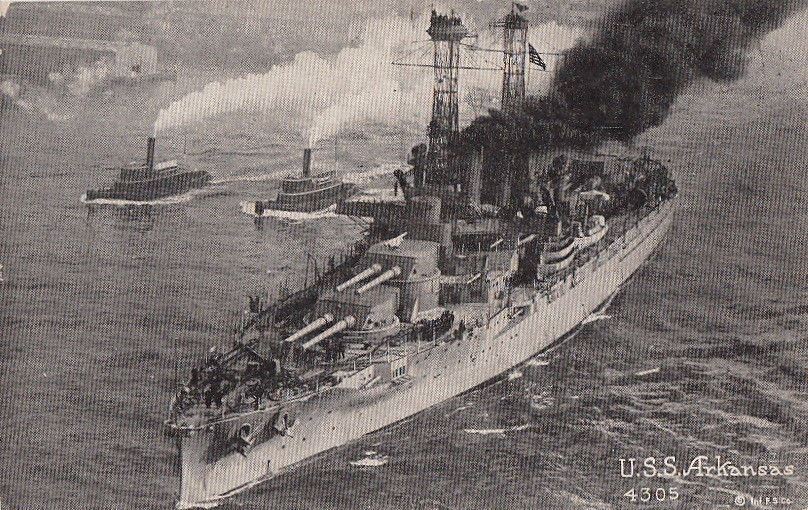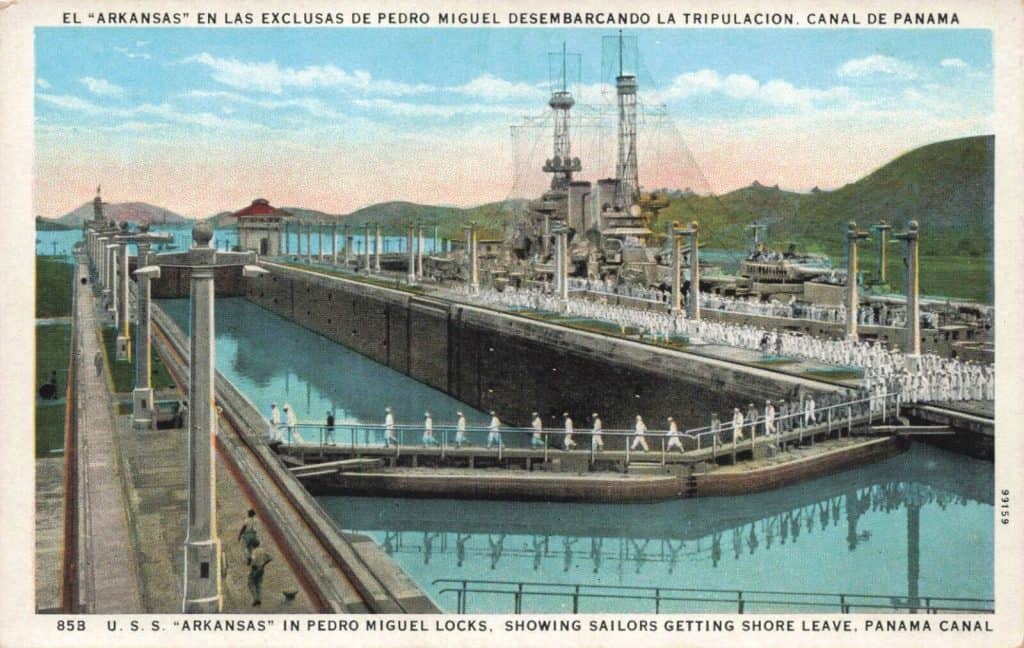Being intrigued by nearly all things regarding the U.S. Navy, I was thrilled to receive this great old AZO real photo card from my friends Dave Martin and Judy Pennycuff. The card is, unfortunately, in terrible condition due to its age and misuse, but it shows an image that begged to be investigated to find the who, where, and what is in the photo.

The story unfolds in the following narrative.
Step one was to identify the age of the card. The stamp box on this unused postcard showed the AZO logo with four triangle shapes: the two at the top pointing up and the two at the bottom pointing down, indicating a publishing period between 1910 and 1930.
The picture, itself, offers several clues. Regarding perspective, the orientation is looking aft along the port side of what must be a very large warship, probably a battleship. Along the rail stands several armed Marines in full dress uniforms along with white uniformed sailors and ship officers standing aft (note the stripes of the flag).
All these people seem to be listening to the man standing high on the structure near the middle of the photo. Now the questions are, who was the speaker and what was the occasion?
Based on the uniforms shown and the general age of the postcard I guessed that the speaker could be Franklin D. Roosevelt who was at the time an Assistant Secretary of the Navy under President Woodrow Wilson. (FDR was not paralyzed by polio until 1921). This was just a lucky guess, but as it turned out, a correct one.
Following up on my guess that it was Roosevelt, a check on what ships Roosevelt may have visited while he was Assistant Secretary of the Navy hit pay dirt. I found that he was an honored guest aboard USS Arkansas (BB 33), on October 25, 1913, just before she sailed for Europe.
USS Arkansas was a “Wyoming Class Battleship” commissioned September 17, 1912, and decommissioned on July 29, 1946.
She was our oldest operational battleship serving through the end of World War II. Arkansas was sunk on July 25, 1946, as part of the Operation Crossroads nuclear bomb test at Bikini Atoll in the Pacific where she is still visited by divers to this day.
***
Continue reading for an expanded look into the history of
U. S. S. Arkansas on Postcards

Arkansas served the United States Navy (unofficially, for 33 years, 10 months, and 18 days (officially, it was 12 days). It would be an unimaginable task to calculate the nautical miles she traveled through the oceans of the earth, but one thing is certain, the men who served aboard did so proudly and with honor.
The postcards below show only two of the sites she visited, but without regard to where she docked, crowds of onlookers gathered to see the BB-33.

(Probably making her way to the Brooklyn Navy Yard on the northeast shore of Wallabout Bay.
***

(Notice the card has two captions: at the top, in Spanish.
at the bottom, in English.)
History of the Arkansas
(courtesy of the U.S. Navy, with comments)
USS Arkansas (BB-33) was a 26,000-ton Wyoming class battleship that was built at Camden, New Jersey. It was the third U.S. Naval vessel to carry the name “Arkansas.” Commissioned in September 1912, she spent her first seven years of service with the Atlantic Fleet. In 1913, Arkansas cruised in the Mediterranean. [There is a good chance that Roosevelt visited the ship while she was headed to a new role in the 1914 U.S. intervention in Mexico.]
Through the next two decades, Arkansas served in both the Atlantic and Pacific doing training operations. After war broke out in Europe in 1939, she continued her training duties, and, as relations with Germany deteriorated, took part in “operations short of war.” In the summer of 1941, she escorted occupation forces to Iceland and was present when President Roosevelt met Prime Minister Churchill at the Atlantic Charter Conference.
Once the United States formally entered the war in December 1941, the ship was employed escorting Atlantic convoys, as well as performing more training work. An overhaul that began in March 1942 again changed her appearance, with a new tripod foremast replacing the previous “basket” type. [Knowing this sets the photograph dates of both the New York and Panama Canal cards above to be before March 1942.]
Her combat experience began in June 1944, when she used her twelve-inch guns to support the Normandy invasion and in bombardments of German defenses at Cherbourg. In August, she participated in the invasion of southern France.
Arkansas transited the Panama Canal at least four times, once in 1919, once in 1921, then in 1925 and again in 1944.
USS Arkansas went to the Pacific in November 1944, crossing the ocean to the war zone early in the next year. From February through May 1945, she supported the conquests of Iwo Jima and Okinawa. Once Japan had surrendered, she transported veterans back to America.
By 1946 Arkansas was thoroughly obsolete, the old battleship was assigned a final mission, to serve as a target ship for atomic bomb tests at Bikini, in the Marshall Islands. She survived the initial test, an airburst, but was anchored in close proximity to the bomb used in the July 25, 1946, underwater shot. The second test resulted in the ship being engulfed in the column of water driven up by the powerful blast and quickly sank.
Excellent post – thank you
Great article. At the start of World War II, most naval experts deemed the battleships Arkansas, Texas, and New York as obsolete. Arkansas’s sister Wyoming had been converted to a gunnery training ship. Yet all three ships did yeoman service during World War II in the European theater. Later when they were transferred to Pacific they performed bombardment duties at Iwo Jima and Okinawa. Texas was preserved as a museum ship at the San Jacinto Battlefield outside Houston. She is undergoing a multi-year overhaul at Galveston, Texas and will be moved to a new home port (to be determined) upon… Read more »
Thank you for sharing your method of researching the ship RPPC. It makes me want to try finding information about a couple of my “hopeless” cards.
I noticed that the card showing the New York skyline includes the notation AUTHORIZED BY CENSOR at the top. Reminded me of the time I visited Cuba and was warned not to photograph military installations.